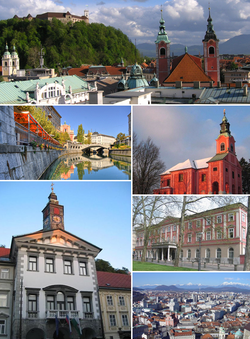Ljubljana
| Ljubljana | |||
|---|---|---|---|
| City | |||

Clockwise from top: Ljubljana Castle in the background and Franciscan Church of the Annunciation in the foreground; Visitation of Mary Church on Rožnik Hill; Kazina Palace at Congress Square; view from Ljubljana Castle towards the north; Ljubljana City Hall; Ljubljanica with the Triple Bridge in distance.
|
|||
|
|||
| Coordinates: 46°03′20″N 14°30′30″E / 46.05556°N 14.50833°ECoordinates: 46°03′20″N 14°30′30″E / 46.05556°N 14.50833°E | |||
| Country | Slovenia | ||
| Municipality | City Municipality of Ljubljana | ||
| First mention | 1112–1125 | ||
| Town privileges | 1220–1243 | ||
| Government | |||
| • Mayor | Zoran Janković (PS) | ||
| Area | |||
| • City | 163.8 km2 (63.2 sq mi) | ||
| Elevation | 295 m (968 ft) | ||
| Population (2016) | |||
| • City |
|
||
| • Density | 1,708/km2 (4,420/sq mi) | ||
| • Metro | 537,712 | ||
| Time zone | CET (UTC+1) | ||
| • Summer (DST) | CEST (UTC+2) | ||
| Postal codes | 1000—1211, 1231, 1260, 1261 | ||
| Area code(s) | 01 (1 if calling from abroad) | ||
| Vehicle Registration | LJ | ||
| Website | www.ljubljana.si | ||
Ljubljana (pronounced [ljuˈbljàːna],locally also: [luˈblàːna]; also known by other alternative names) is the capital and largest city of Slovenia. During antiquity, it was the site of a Roman city called Emona. It was under Habsburg rule from the Middle Ages until the dissolution of the Austro-Hungarian Empire in 1918.
Situated at the middle of a trade route between the northern Adriatic Sea and the Danube region, it was the historical capital of Carniola, a Slovene-inhabited part of the Habsburg Monarchy, and it has been the cultural, educational, economic, political, and administrative center of independent Slovenia since 1991. Its central geographic location within Slovenia, transport connections, concentration of industry, scientific and research institutions, and cultural tradition are contributing factors to its leading position.
The origin of the city's name is unclear. In the Middle Ages, both the river and the town were also known by the German name Laibach. This name was in official use as an endonym until 1918, and it remains frequent as a German exonym, both in common speech and official use. The city is called in Italian Lubiana and in Latin: Labacum or Aemona For most scholars, the problem has been in how to connect the Slovene and the German names. The origin from the Slavic ljub- LYOOB "to love, like" was in 2007 supported as the most probable by the linguist Tijmen Pronk, a specialist in comparative Indo-European linguistics and Slovene dialectology, from the University of Leiden. He supported the thesis that the name of the river derived from the name of the settlement. The linguist Silvo Torkar, who specializes in Slovene personal and place names, argued at the same place for the thesis that the name Ljubljana derives from Ljubija, the original name of the Ljubljanica River flowing through it, itself derived from the Old Slavic male name Ljubovid, "the one of a lovely appearance". The name Laibach, he claimed, was actually a hybrid of German and Slovene and derived from the same personal name.
...
Wikipedia


